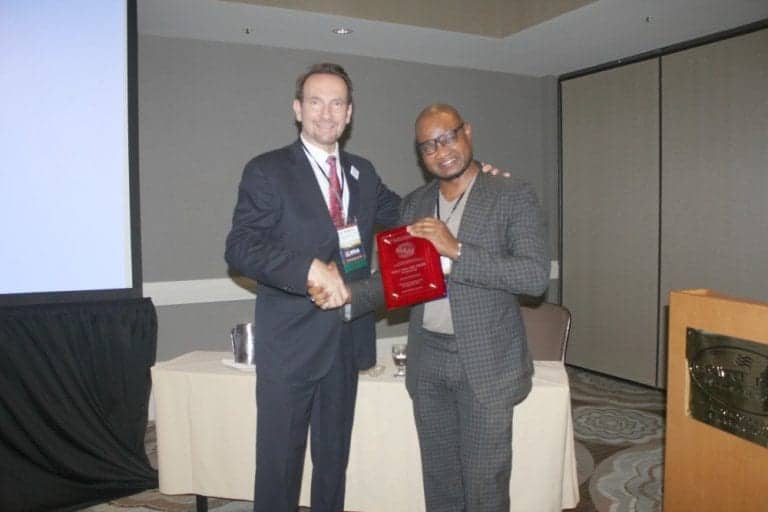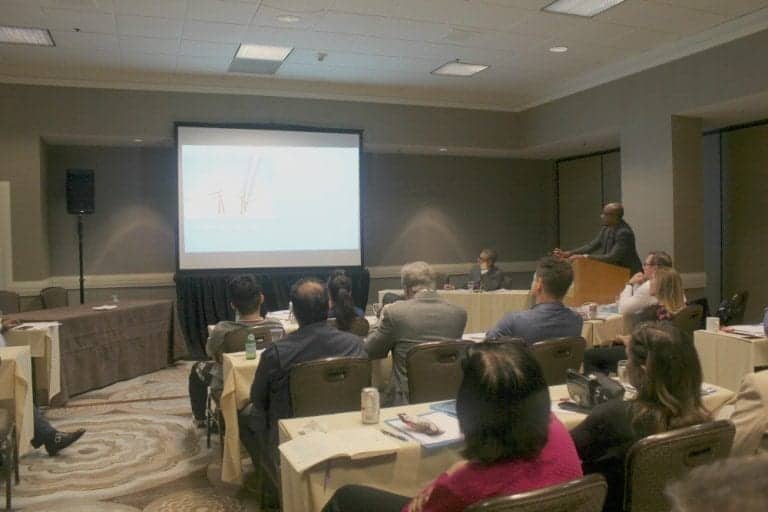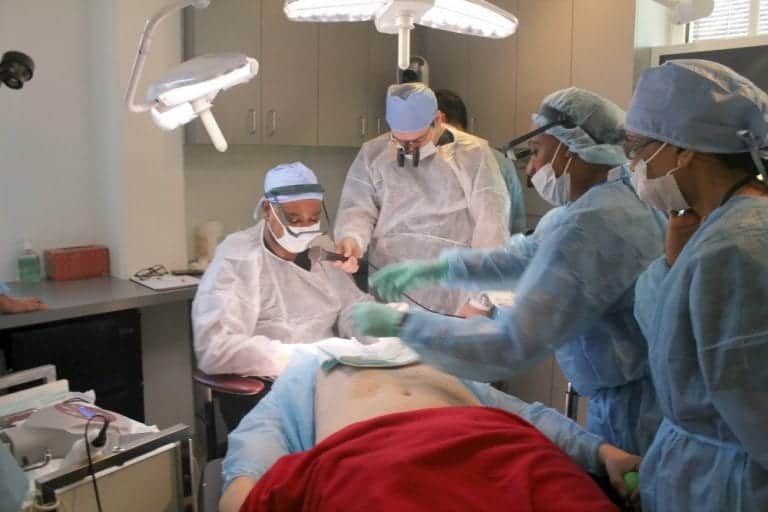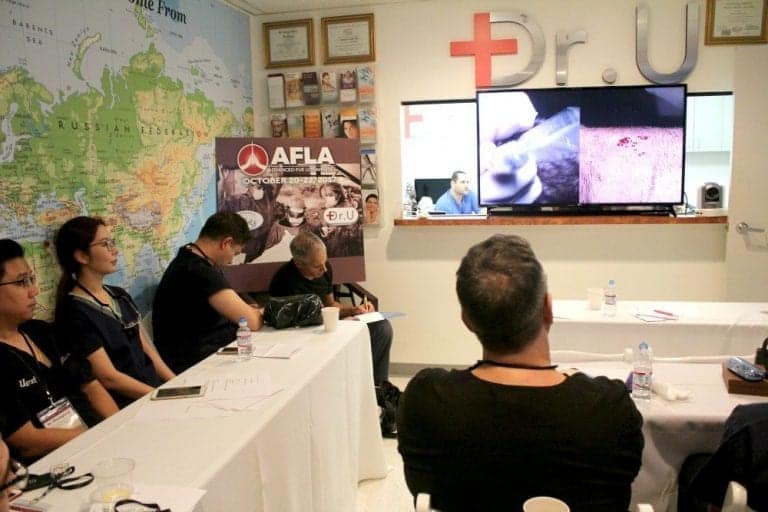2017 ISHRS President, Dr. Ken Washenik presented Dr. Umar with an award to express their appreciation and recognition for his demonstration of educational excellence at the AFLA (advanced FUE Los Angeles) workshop, sponsored by the organization. The ISHRS (International Society of Hair Restoration Surgery) is a non-profit organization that promotes education in hair loss treatment. Dr. Umar who hosted and chaired the event organized a phenomenally insightful and informative 3 day experience for his hair restoration colleagues on advanced knowledge and new frontiers in FUE methods.

Exploring New Frontiers With Emerging and Complex FUE Methods and Techniques
The faculty panel of lecturers at the ISHRS workshop shared their expertise on a wide range of enlightening and in-depth topics in Follicular Unit Extraction. As actual practitioners themselves, they were also able to impart their time tested wisdom on best FUE methods and hair transplant practices.
William Rassman MD
- Unshaven (long hair) FUE using non-rotary punch
- Implanters: current methods combination
- Hair transplantation in the donor challenged patient
Jim Harris MD, FISHRS
- Donor management
- The blunt punch and applications
- Unshaven long hair FUE using non-rotary punch
Parsa Mohebi MD, FISHRS
- Robotic FUE
Rattapon Thuangtong MD
- Robotic FUE
- Inflammatory scalp conditions
Jeffrey Epstein MD
- Body hair restoration for the eyebrows and beard area
Ronald Shapiro MD, FISHRS
- Hairlines in repair and severe bald states
Sheldon Kabaker, MD
- Repair of the hair-bearing scalp at the subgaleal level
Ken Williams Jr., D.O., FISHRS
- Lower level therapy and stem cell therapy in hair restoration
Ken Washenik MD, PHD, FISHRS
- Emerging hair loss therapies
Dr. Umar himself spoke about the best practices and FUE methods that he applies towards hair transplant insertions, body hair extractions, his Dr.UGraft innovations which now includes the world’s first ever Ultrasonic FUE extraction device that he is developing and how he engineered these instruments to overcome perplexing hair restoration challenges that surgeons have long been struggling with.

Whereas most FUE rotary punches are considered either sharp or dull, the Dr.UPunch i ™ (The Intelligent Punch) is designed as a unique, all in one hybrid of the two. Dull edged punches safely encompass follicular units comprised of multiple hair follicles. When there is more than one hair follicle in a grouping, the tail ends may splay (spread) at the bottom and can easily become severed by the circular blades of cylindrical punches. Sharp punches are more specialized to cut the surrounding tissue around the hair follicles so that they can be freed. But if they are inserted too deeply when the surgeon attempts to encapsulate the length of the hair follicle, they can easily sever the graft.
During his ISHRS presentation, Dr. Umar explained that the hybrid Dr.UPunch i ™ integrates the concepts of the sharp and dull punch into a single feature. With this extraction device, the cutting edge is directed away from the hair follicle unit. Even in cases of splayed ends, a curved surface faces the graft, preventing it from being injured by a sharp edge.
This design is able to carry out extractions with a more shallow cutting depth, compared to conventional punches. Therefore, it is able to safely remove follicles of any hair angulation, including body hair. Doctors no longer have to rely on guesswork when navigating the course of the hair follicle. And with this tool, they easily improve their success rate in being able to more easily extract healthy, bulkier grafts, a very important consideration in the general realm of FUE methods.
Engineered for the purpose of harvesting tightly curled Afro-textured hair, the non-rotary Dr.UPunch Curl™ is another of Dr. Umar’s breakthrough innovations within the UGraft set of devices.
Some hair follicles within the demographic of black patients may have curvatures as great as 260 degrees, which no cylindrical shaped punch can follow. The Dr.UPunch Curl™ is a two-pronged structure built with curved blades at the very bottom to make a precise outer incision to trace the curl of the hair follicle. Not only does this accommodate the unique shape of the graft, but it also addresses the issue of tougher, stubborn tissue attachments in the dermis. The overall design represents a major improvement from conventional FUE tools which causes surgeons to apply greater force that is likely to injure the follicle.
Both the Dr.UPunch i ™ and the Dr.UPunch Curl™ can be attached to UGraft fluid irrigation system. This component deposits hydration on the hair follicle to keep it moist and protect it from air drying. With a foot pedal control, the surgeon can also expel impacted hair grafts using fluid, instead of forceps which can severely damage the delicate structures.
At the ISHRS Los Angeles regional workshop. Dr. Umar also introduced his latest Dr.UGraft innovation, ultrasonic FUE. This technology represents a cutting-edge advancement among current FUE methods since it uses ultrasound wave vibrations to soften and break up surrounding scalp tissue, allowing surgeons to more easily remove hair follicles.
Although there are many applications for this capability, ultrasonic FUE would most benefit surgeries where the patient does not want to shave their head for a hair transplant procedure due to work or social reasons. The use of ultrasound would facilitate the doctor’s ability to extract grafts without the need to actually trace the follicle, a process that can be difficult with normal hair lengths.
ISHRS Live Surgery Demonstrations in Los Angeles: Body Hair to Head Transplant & African American FUE Methods

FUE speaker presentations comprised the first day of the ISHRS Workshop. The concepts, insights and ideas on FUE methods discussed by Dr. Umar during his Dr.UGraft lecture segments were brought to life for the attendees through live surgery demonstrations conducted on the second and third days of the event.
On day 2, ISHRS members watched a live streamed procedure demonstration of a body hair transplant using beard hair grafts to further improve the density of one of Dr. Umar’s repair patients. This experience allowed surgeons to actually see the features of the Dr.UPunch i™ at work to remove viable beard hair donor grafts which were later transplanted on the scalp.

On day 3 of the ISHRS regional workshop, Dr. Umar performed a second live surgery, this time presenting the use of his Dr.UPunch Curl ™ device on an African American patient. ISHRS colleagues watched how this particular device can be applied to perform safe extractions on curved hair follicles.
During the both procedures, Dr. Umar also showed his colleagues how he diffusely selects grafts in the donor regions to avoid creating noticeable lines and patterns, whether on the face, head or other region of the body.
FUE hair transplantation continues to evolve and make forward strides to enable the best possible patient outcomes, thanks to continuing education programs and events provided by organizations like the ISHRS. Dr. Umar is a proud member who plans to make further contributions to this field in order to benefit both patient results and the knowledge of surgeons who practice Follicular Unit Extraction.
If you are considering a hair transplant surgery and would like to schedule a complimentary initial consultation with Dr. Umar, click the button below.
Frequently Asked Questions – ISHRS
1. How can a hair transplant doctor become a member of the ISHRS?
The ISHRS requires interested hair transplant physicians to submit a membership application form, along with the required application fee, a copy of their medical license as well as two letters of recommendation
2. Does the ISHRS only endorse FUE methods?
No, the ISHRS is dedicated to the principle of non-bias in terms of promoting education for hair restoration. This would include both currently available surgical techniques, Follicular Unit Extraction and strip surgery as well as medical approaches to addressing and managing hair loss.
Further Reading
Learn more about the mission of the International Society of Hair Restoration Surgery



